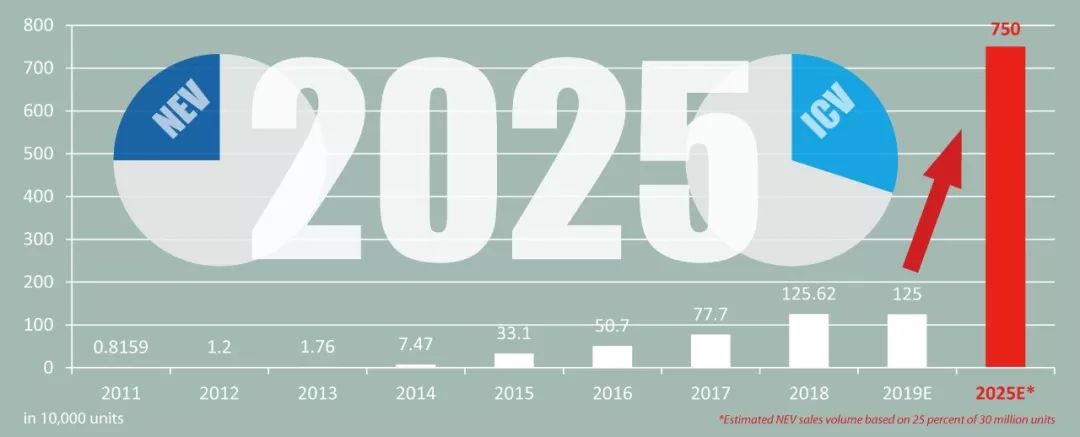BEIJING – China wants new energy vehicles (NEV) to account for about a quarter of new vehicle sales by 2025 and increase the share of intelligent connected vehicles (ICV) to 30 percent by then, according to a draft proposal of an industry plan released by the Ministry of Industry and Information Technology (MIIT) on December 3.

NEVs and ICVs to account for a quarter and 30 percent respectively of new vehicle sales by 2025
The draft version of the New Energy Vehicle Industry Development Plan (2021-2035), essentially the country's roadmap for NEV and ICV development for the next 15 years, is seeking public feedback for a week until December 9, with the final version likely to be released by the end of the year.
The Plan has also set specific targets to improve basic technologies for NEVs, aiming to reduce average electricity consumption of new battery electric vehicle (BEV) fleets to 12 kWh/100 km and average fuel consumption of new plug-in hybrid electric vehicle (PHEV) fleets to 2 L/100 km by 2025. Highly automated ICVs shall be commercialized in restricted zones and under special scenarios, while breakthroughs in power battery and management systems, motor and electronics, and connected and smart technologies shall be achieved by then.
Draft proposal of New Energy Vehicle Industry Development Plan (2021-2035)
New vehicles added or upgraded for public use in National Ecological Civilization Pilot Zones and key regions for air pollution control shall exclusively be NEVs starting in 2021, according to the Plan.
China considers BEVs, PHEVs (including EREVs) and FCEVs as NEVs.
“Through continued efforts over the next 15 years, China will seek to become a global automotive powerhouse with NEV core technologies reaching internationally advanced levels and relative strong global competitiveness in quality and branding,” said the Plan. “BEVs will become mainstream by then with fuel cell electric vehicles (FCEVs) commercialized. Public transport will have been completely electrified with highly automated driving ICVs popularized to effectively boost energy-saving and emissions reduction capabilities and social operational efficiency.”
The draft of the Plan comes out amid four consecutive months of negative growth for NEV sales since July 2019 and 16 consecutive months of negative growth for overall auto sales since July 2018.
The 25 percent NEV share target for 2025 is also daunting: translated to sales volume it would mean anywhere between 6.25 million and 7.5 million units based on annual new vehicle sales of 25 million or 30 million units for 2025. That would be about 6X the roughly 1.25 million NEVs sold in 2018.
China's NEV sales grew only 10 percent through the first 10 months of 2019 to just under 950,000 units and is in danger of falling below last year's level of 1.25 million units at the current pace.
NEV sales in 2019 are likely to be flat over 2018 based on the current trajectory of growth but the share of NEVs will actually grow from last year's 4.5 percent to more than 5 percent this year due to a lower new vehicle sales base of about 25 million units versus last year's 28 million units. In any case, it would mean roughly a 5X growth in proportion terms (from 5 percent to 25 percent) over the next five years.
With NEV subsidies completely phased out by the end of 2020, China will likely use “stick” measures such as zero emissions zones prohibiting the use of ICE vehicles, ICE vehicle license plate controls and NEV usage incentives as well as hoping that total cost of ownership for an NEV will be on a par with ICE vehicles to drive up NEV sales.
The fact that the Plan only stipulated NEV and ICV share targets for 2025 (ambitious by any measure) but not for 2026 and beyond even though it's a 15-year roadmap shows the country's determination and confidence in driving up NEV sales in the near-term but also a more lenient and careful stance over the long-term: specific targets are likely to be announced closer to 2025 based on actual market performance.
A more in-depth version of this article will appear in our December 2019 (Vol. 14, No. 12) issue of China Automotive Review, our monthly e-magazine in English focused exclusively on the Chinese auto market.




